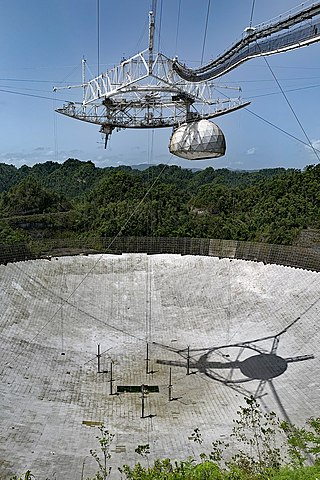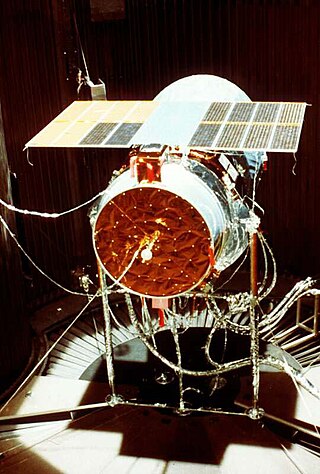
The Hubble Space Telescope is a space telescope that was launched into low Earth orbit in 1990 and remains in operation. It was not the first space telescope, but it is one of the largest and most versatile, renowned as a vital research tool and as a public relations boon for astronomy. The Hubble telescope is named after astronomer Edwin Hubble and is one of NASA's Great Observatories. The Space Telescope Science Institute (STScI) selects Hubble's targets and processes the resulting data, while the Goddard Space Flight Center (GSFC) controls the spacecraft.

The Royal Observatory, Greenwich is an observatory situated on a hill in Greenwich Park in south east London, overlooking the River Thames to the north. It played a major role in the history of astronomy and navigation, and because the Prime Meridian passed through it, it gave its name to Greenwich Mean Time, the precursor to today's Coordinated Universal Time (UTC). The ROG has the IAU observatory code of 000, the first in the list. ROG, the National Maritime Museum, the Queen's House and the clipper ship Cutty Sark are collectively designated Royal Museums Greenwich.

The Arecibo Observatory, also known as the National Astronomy and Ionosphere Center (NAIC) and formerly known as the Arecibo Ionosphere Observatory, is an observatory in Barrio Esperanza, Arecibo, Puerto Rico owned by the US National Science Foundation (NSF).

Photometry, from Greek photo- ("light") and -metry ("measure"), is a technique used in astronomy that is concerned with measuring the flux or intensity of light radiated by astronomical objects. This light is measured through a telescope using a photometer, often made using electronic devices such as a CCD photometer or a photoelectric photometer that converts light into an electric current by the photoelectric effect. When calibrated against standard stars of known intensity and colour, photometers can measure the brightness or apparent magnitude of celestial objects.

Yerkes Observatory is an astronomical observatory located in Williams Bay, Wisconsin, United States. The observatory was operated by the University of Chicago Department of Astronomy and Astrophysics from its founding in 1897 to 2018. Ownership was transferred to the non-profit Yerkes Future Foundation (YFF) in May 2020, which began restoration and renovation of the historic building and grounds. Re-opening for public tours and programming began May 27, 2022.

The Infrared Astronomical Satellite (IRAS) was the first space telescope to perform a survey of the entire night sky at infrared wavelengths. Launched on 25 January 1983, its mission lasted ten months. The telescope was a joint project of the United States (NASA), the Netherlands (NIVR), and the United Kingdom (SERC). Over 250,000 infrared sources were observed at 12, 25, 60, and 100 micrometer wavelengths.

The Spitzer Space Telescope, formerly the Space Infrared Telescope Facility (SIRTF), is an infrared space telescope launched in 2003, that was deactivated when operations ended on 30 January 2020. Spitzer was the third space telescope dedicated to infrared astronomy, following IRAS (1983) and ISO (1995–1998). It was the first spacecraft to use an Earth-trailing orbit, later used by the Kepler planet-finder.

The Gemini Observatory comprises two 8.1-metre (26.6 ft) telescopes, Gemini North and Gemini South, situated in Hawaii and Chile, respectively. These twin telescopes offer extensive coverage of the northern and southern skies and rank among the most advanced optical/infrared telescopes available to astronomers. (See List of largest optical reflecting telescopes).

The Apache Point Observatory is an astronomical observatory located in the Sacramento Mountains in Sunspot, New Mexico, United States, approximately 18 miles (29 km) south of Cloudcroft. The observatory is operated by New Mexico State University (NMSU) and owned by the Astrophysical Research Consortium (ARC). Access to the telescopes and buildings is private and restricted.

NASA's series of Great Observatories satellites are four large, powerful space-based astronomical telescopes launched between 1990 and 2003. They were built with different technology to examine specific wavelength/energy regions of the electromagnetic spectrum: gamma rays, X-rays, visible and ultraviolet light, and infrared light.

Armagh Observatory is an astronomical research institute in Armagh, Northern Ireland. Around 25 astronomers are based at the observatory, studying stellar astrophysics, the Sun, Solar System astronomy and Earth's climate.

The Royal Observatory of Belgium, has been situated in the Uccle municipality of Brussels, Belgium, since 1890. It was first established in Saint-Josse-ten-Noode in 1826 by King William I of the Netherlands under the impulse of Adolphe Quetelet. It was home to a 100 cm (39 in) diameter aperture Zeiss reflector in the first half of the 20th century, one of the largest telescopes in the world at the time. It now owns a variety of other astronomical instruments, such as astrographs, as well as a range of seismograph equipment.
Rebecca Oppenheimer is an American astrophysicist and one of four curator/professors in the Department of Astrophysics at the American Museum of Natural History (AMNH) on Manhattan's Upper West Side. Oppenheimer is a comparative exoplanetary scientist. She investigates planets orbiting stars other than the Sun. Her optics laboratory is the birthplace of a number of new astronomical instruments designed to tackle the problem of directly seeing and taking spectra of nearby solar systems with exoplanets and studying their composition, with the ultimate goal of finding life outside the solar system.

The Australian Square Kilometre Array Pathfinder (ASKAP) is a radio telescope array located at Murchison Radio-astronomy Observatory (MRO) in the Mid West region of Western Australia.

Astronomy & Geophysics (A&G) is a scientific journal and trade magazine published on behalf of the Royal Astronomical Society (RAS) by Oxford University Press. It is distributed bimonthly to members of the RAS.

Aryabhatta Research Institute of Observational Sciences (ARIES) is a research institute in Nainital, Kumaon, India which specializes in astronomy, solar physics, astrophysics and atmospheric science. It is an autonomous body under the Department of Science and Technology, Government of India. The institute is situated at Manora Peak (elevation 1,951 m or 6,401 ft), about 9 kilometres (5.6 mi) from Nainital, headquarters of Kumaon division.

The Precision Integrated-Optics Near-infrared Imaging ExpeRiment (PIONIER) is a visiting instrument at the ESO's Paranal Observatory, part of the VLTI astronomical observatory. It combines the light from four telescopes simultaneously and provide 0.002 arc seconds of angular resolution, the equivalent angular resolution of a 100 m telescope.

The Nancy Grace Roman Space Telescope is a NASA infrared space telescope in development and scheduled to launch by May 2027.

Fine Guidance Sensor (FGS) for the Hubble Space Telescope is a system of three instruments used for pointing the telescope in space, and also for astrometry and its related sciences. To enable aiming the telescope at a specific spot in the sky, each FGS combines optics and electronics. There are three Hubble FGS, and they have been upgraded over the lifetime of the telescope by crewed Space Shuttle missions. The instruments can support pointing of 2 milli-arc seconds. The three FGS are part of the Hubble Space Telescope's Pointing Control System, aka PCS. The FGS function in combination with the Hubble main computer and gyroscopes, with the FGS providing data to the computer as sensors which enables the HST to track astronomical targets.

Origins Space Telescope (Origins) is a concept study for a far-infrared survey space telescope mission. A preliminary concept in pre-formulation, it was presented to the United States Decadal Survey in 2019 for a possible selection to NASA's large strategic science missions. Origins would provide an array of new tools for studying star formation and the energetics and physical state of the interstellar medium within the Milky Way using infrared radiation and new spectroscopic capabilities.


















